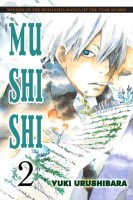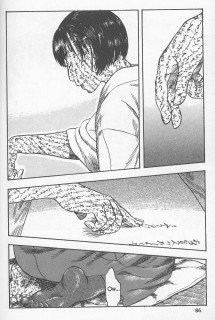 Creator: Yuki Urushibara
Creator: Yuki Urushibara
U.S. publisher: Del Rey
ISBN: 9780345496447
Released: July 2007
Original release: 2002
Awards: Japan Media Arts Award, Kodansha Manga Award
Yuki Urushibara’s debut manga series Mushishi is a work that is quite dear to me. I discovered it more by accident than anything else, but Mushishi quickly became one of my favorite manga when it was first released in English and it remains a series that I enjoy immensely. Urushibara has taken cues from traditional Japanese folklore and mythology, creating a series with a quiet yet creepy atmosphere and a subtle sense of horror that relies on the interactions between humans and natural powers beyond their control. Mushishi has inspired multiple anime adaptations, which are also excellent, as well as a live-action film. The series has also been honored with a Japan Media Arts Award and a Kodansha Manga Award. Mushishi, Volume 2 was originally published in Japan in 2002. The volume was first released in English by Del Rey Manga in 2007. It is now available digitally by Kodansha Comics, but I hope that one day Mushishi will be brought back into print.
Mushishi, Volume 2 collects five stories, some of which are among my personal favorites in the series. “The Mountain Sleeps” finds Ginko coming to the aid of a fellow mushishi who is feared to have gone missing. “The Sea of Brushstrokes” tells the tale of a young woman whose family has collected stories about mushi for generations, becoming the guardians of a vast library of valuable knowledge. Ginko travels to a remote island that can only be accessed once every lunar month due to the tides and currents in “They That Breathe Ephemeral Life.” Back on the mainland, he joins up with a man wandering the countryside searching for a rare type of mushi in “Rain Comes and a Rainbow Is Born.” In the final story, “The Green Veil,” Ginko must convince a recently married couple to give up their children, none of whom are human despite their outward appearances.
 Mushishi tends to be fairly episodic, though the stories do share similar elements. The individual chapters don’t necessarily build directly on one another, but they do expand and develop more and more about the world Urushibara has created. What I particularly enjoy about Mushishi, Volume 2 is how it places Ginko within the greater context of the relatively small community of mushishi. He is only one mushishi out of many, sharing some likenesses with the others in his profession but also exhibiting personal differences. It is revealed in the second volume of Mushishi that one of the reasons Ginko is constantly traveling from place to place is that he attracts mushi; if he doesn’t keep moving the area around him will become infested. However, as is also seen in Mushishi, Volume 2, some mushishi are able to make permanent homes for themselves. In some extreme cases, they even become trapped by their duties, unable to leave without causing great harm to others.
Mushishi tends to be fairly episodic, though the stories do share similar elements. The individual chapters don’t necessarily build directly on one another, but they do expand and develop more and more about the world Urushibara has created. What I particularly enjoy about Mushishi, Volume 2 is how it places Ginko within the greater context of the relatively small community of mushishi. He is only one mushishi out of many, sharing some likenesses with the others in his profession but also exhibiting personal differences. It is revealed in the second volume of Mushishi that one of the reasons Ginko is constantly traveling from place to place is that he attracts mushi; if he doesn’t keep moving the area around him will become infested. However, as is also seen in Mushishi, Volume 2, some mushishi are able to make permanent homes for themselves. In some extreme cases, they even become trapped by their duties, unable to leave without causing great harm to others.
Mushishi, Volume 2 reinforces one of the most important themes of the series—the sanctity of life and the deep respect that it deserves—and emphasizes the need for humans to coexist with mushi. These concepts are explored in various ways throughout Mushishi. In the second volume, Ginko in particular is shown to give priority to human lives, but he also avoids destroying mushi whenever possible. However, some mushishi seem to take great delight in the eradication of the mushi they encounter. This lack of compassion and understanding by mushishi as well as other humans can be problematic; they try to exert their control over, manipulate, and use to their advantage these creatures which are frequently beyond their ken, often with tragic results. At times mushi can be dangerous if left completely unchecked, but just as dangerous is unrestrained human arrogance.

Speak Your Mind